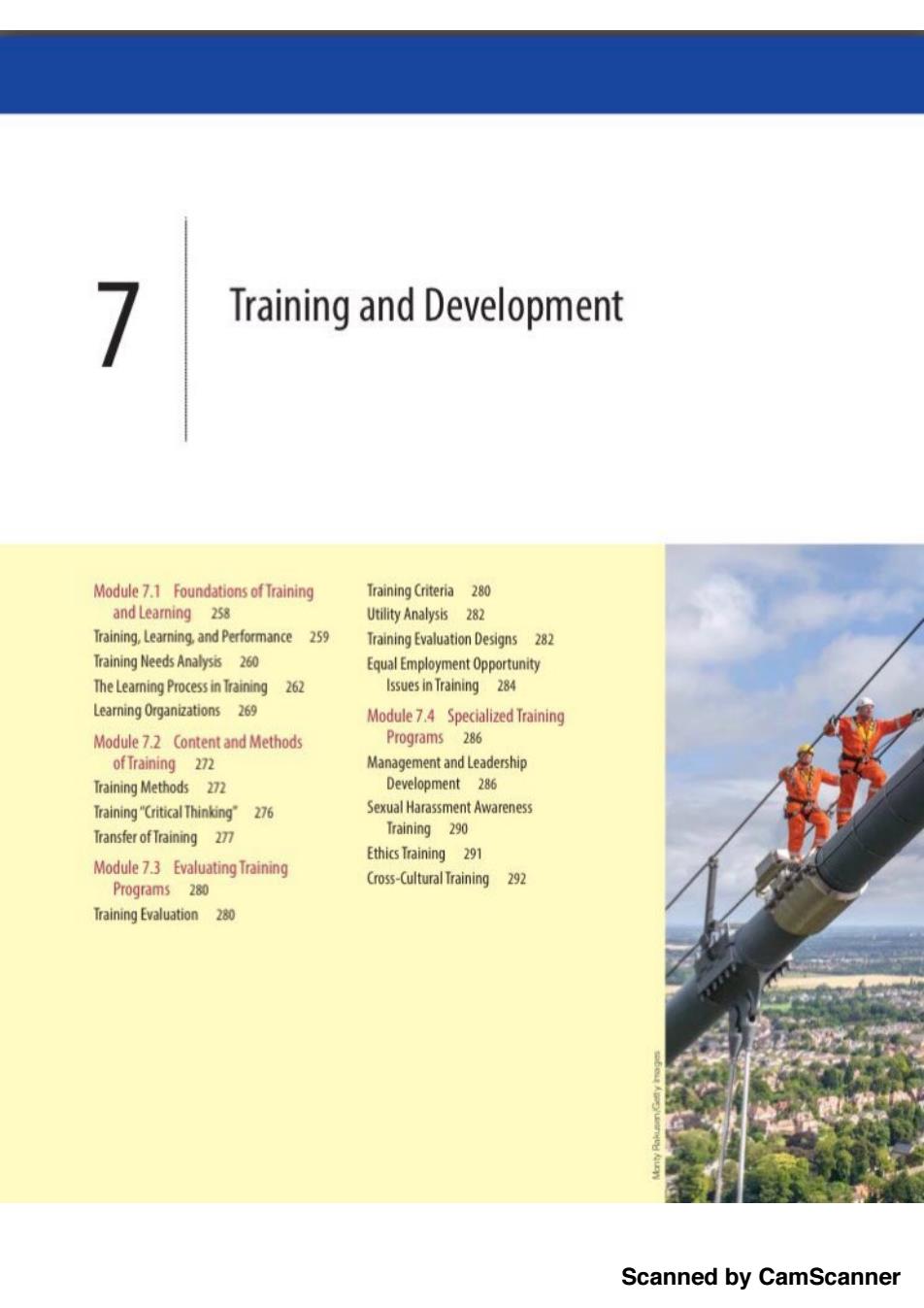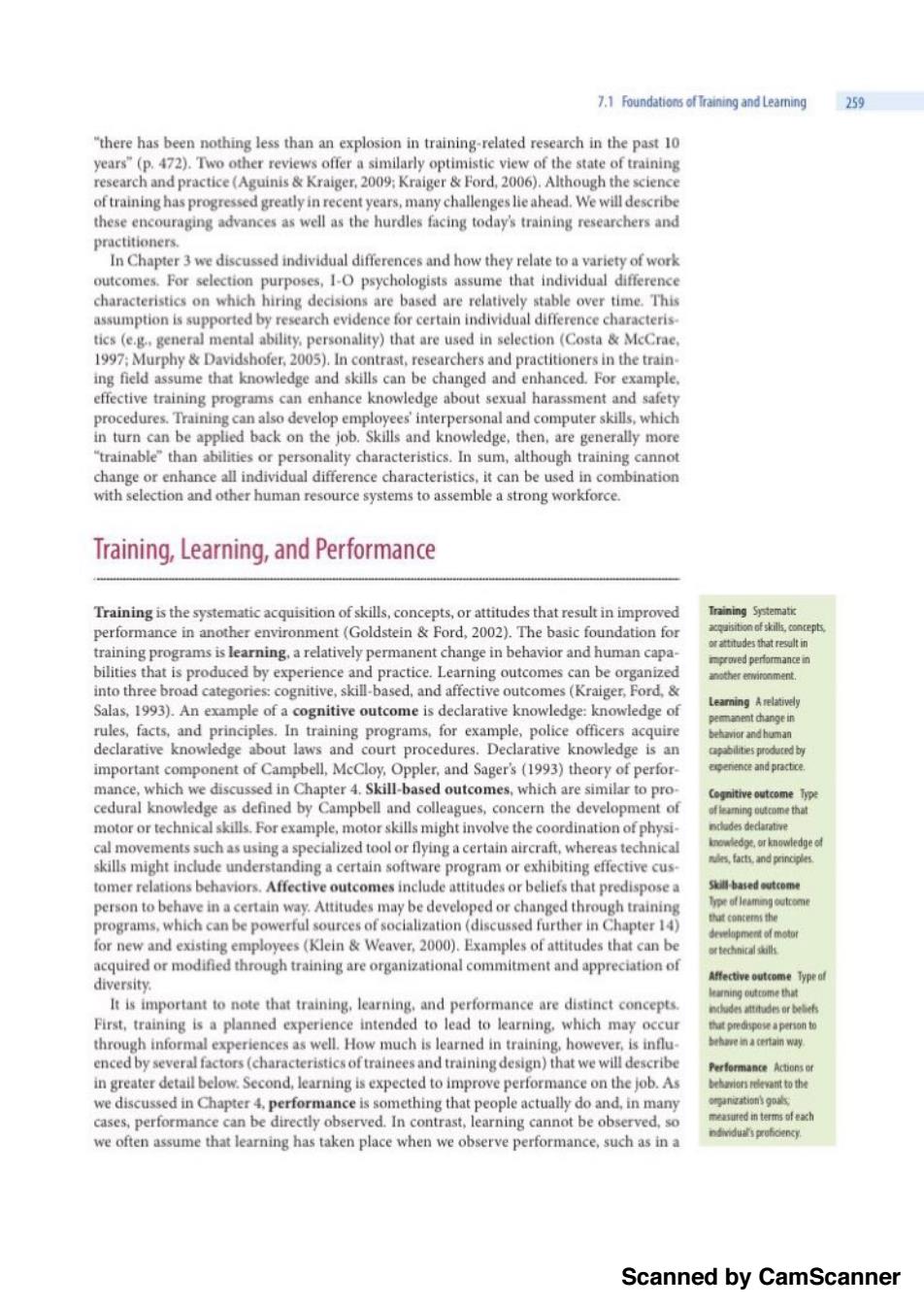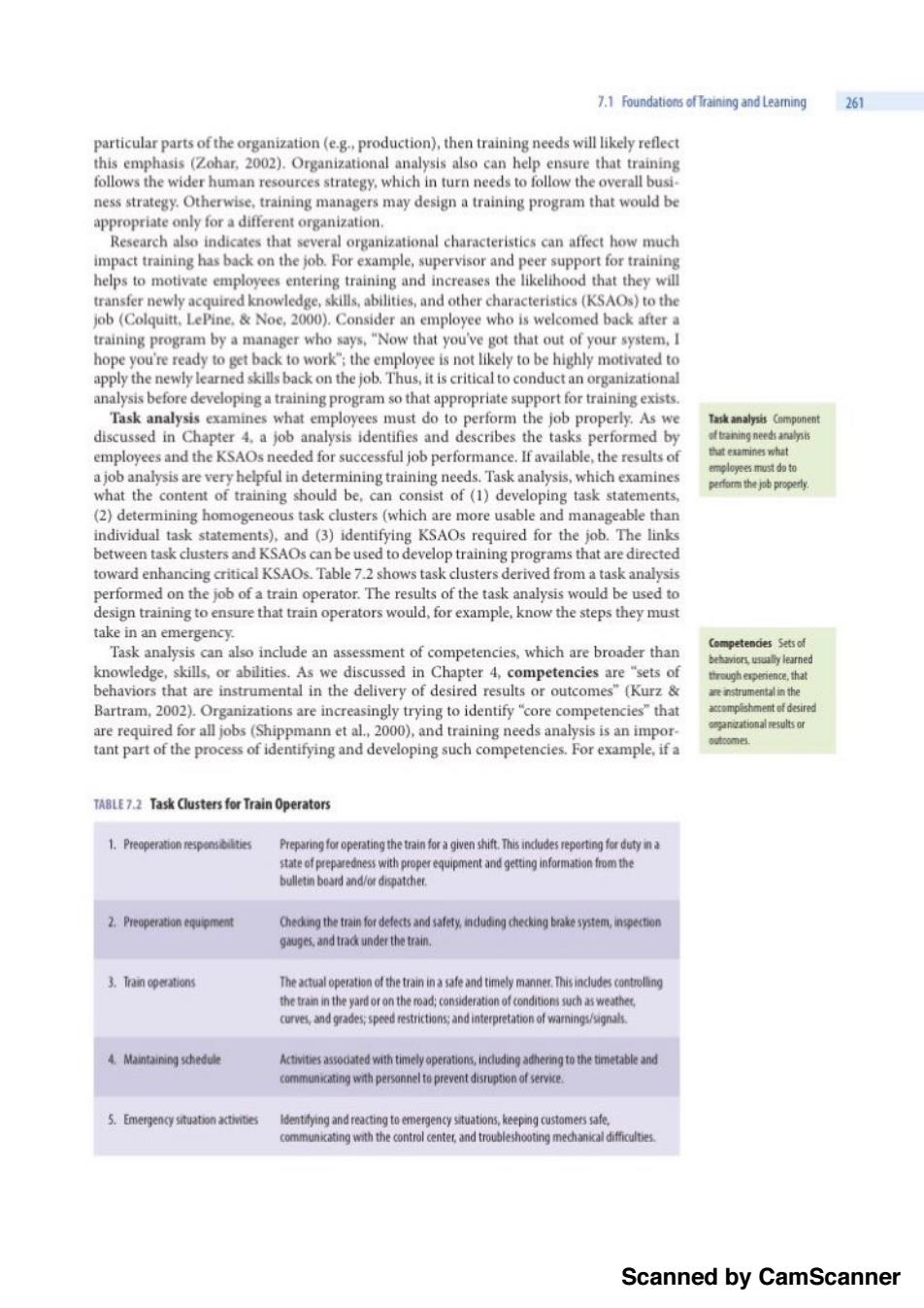
/ Training and Development Module 7.1 Foundations of Training Training Criteria 280 and Learning 258 Utility Analysis 282 Training,Learning,and Performance 259 Training Evaluation Designs 282 Training Needs Analysis 260 Equal Employment Opportunity The Learning Process in Training 262 Issues in Training 284 Learning Organizations 269 Module 7.4 Specialized Training Module 7.2 Content and Methods Programs 286 of Training 272 Management and Leadership Training Methods 272 Development 286 Training"Critical Thinking"276 Sexual Harassment Awareness Transfer of Training 277 Training 290 Ethics Training 291 Module 7.3 Evaluating Training Programs 280 Cross-Cultural Training 292 Training Evaluation 280 Scanned by CamScanner
Scanned by CamScanner

MODULE 7.1 Foundations of Training and Learning Jackie slid into the driver's seat and checked the map one more time before backing out of the garage.It was Monday,and for the duration of the week she would be commuting not to her office but to an off-site center where she and other new managers from various departments and locations in her company would receive training to develop their supervi- sory skills.As she drove,Jackie realized that she was more nervous than she had anticipated. She didn't know what to expect from the training program,in terms of either what would be required of her or what she would be learning.She also wondered how her fellow engi- neers,who had become her subordinates when she was promoted,would react when she returned to work.Would they be on the lookout for her to "act like a manager"instead of like a colleague?She wasn't even sure how supportive her own boss was of this training program or of any changes in her supervisory style that might result from it.As we will describe in this chapter,Jackie's apprehension about the purpose and effects of the training program is legitimate.I-O psychologists have done a great deal of research on training rel. evant to Jackie's concerns and questions.Research on training has also provided guidelines for training practitioners about the best ways to identify training needs,design and imple- ment training programs,and evaluate the effectiveness of training. Training is big business,particularly in the United States,Japan,and western Europe. A survey by researchers at the American Society for Training and Development(2010) indicated that training expenditures as a percentage of payroll averaged about 3 percent in European companies,2 percent in U.S.organizations,and I percent in Japanese companies. Organizations in the United States spend approximately $162 billion annually on training and development(American Society for Training and Development,2013).Evidence indi. cates that training is effective and that these training expenditures are paying off in terms of higher net sales and gross profitability per employee(Arthur,Bennett,Edens,Bell,2003). Training can be beneficial for the organization and for employees in terms of increasing their value to their organization as well as their employability in the broader marketplace. Many organizations are using training and development as a way to attract and retain their most successful employees.In addition,web-based and computer-based training are increasingly being used to expand employees'access to training (Welsh.Wanberg.Brown, Simmering,2003). Given how expensive and important training is,it is important for I-O psychologists to use a systematic approach to training that includes an assessment of training needs,incor- poration of principles of learning,consideration of transfer of the training,and evaluation of training programs.In this chapter,we will discuss this systematic approach,which has resulted in great strides in our understanding of training and development. In an assessment of training research over the preceding decade,Salas and Cannon- Bowers (2001)expressed optimism about the fact that there are more theories,models. empirical studies,and meta-analyses on training than ever before.They concluded that Scanned by CamScanner
Scanned by CamScanner

7.1 Foundations of Training and Leaming 259 "there has been nothing less than an explosion in training-related research in the past 10 years"(p.472).Two other reviews offer a similarly optimistic view of the state of training research and practice (Aguinis Kraiger.2009:Kraiger Ford,2006).Although the science of training has progressed greatly in recent years,many challenges lie ahead.We will describe these encouraging advances as well as the hurdles facing today's training researchers and practitioners. In Chapter 3 we discussed individual differences and how they relate to a variety of work outcomes.For selection purposes,1-0 psychologists assume that individual difference characteristics on which hiring decisions are based are relatively stable over time.This assumption is supported by research evidence for certain individual difference characteris- tics (e.g,general mental ability.personality)that are used in selection(Costa McCrae. 1997:Murphy Davidshofer,2005).In contrast,researchers and practitioners in the train- ing field assume that knowledge and skills can be changed and enhanced.For example, effective training programs can enhance knowledge about sexual harassment and safety procedures.Training can also develop employees'interpersonal and computer skills,which in turn can be applied back on the job.Skills and knowledge,then,are generally more "trainable"than abilities or personality characteristics.In sum,although training cannot change or enhance all individual difference characteristics,it can be used in combination with selection and other human resource systems to assemble a strong workforce. Training,Learning,and Performance Training is the systematic acquisition of skills,concepts,or attitudes that result in improved Training Systemati performance in another environment(Goldstein Ford,2002).The basic foundation for acaisition of skills.conrepts rtttudes that resut in training programs is learning.a relatively permanent change in behavior and human capa- n字wtdp向mmance in bilities that is produced by experience and practice.Learning outcomes can be organized another eewiroement. into three broad categories:cognitive,skill-based,and affective outcomes(Kraiger,Ford, Learning Arelatively Salas,1993).An example of a cognitive outcome is declarative knowledge:knowledge of ea0t中angn rules,facts,and principles.In training programs,for example,police officers acquire behavior and human declarative knowledge about laws and court procedures.Declarative knowledge is an es prodared b可 important component of Campbell,McCloy,Oppler,and Sager's(1993)theory of perfor- agenence and practice mance,which we discussed in Chapter 4.Skill-based outcomes,which are similar to pro- Cognitive outcome Type cedural knowledge as defined by Campbell and colleagues,concern the development of motor or technical skills.For example,motor skills might involve the coordination of physi- cal movements such as using a specialized tool or flying a certain aircraft,whereas technical ledge.or knowtedgeof skills might include understanding a certain software program or exhibiting effective cus- sfarts and principles tomer relations behaviors.Affective outcomes include attitudes or beliefs that predispose a Skill-based outcome person to behave in a certain way.Attitudes may be developed or changed through training ype of leaming outcome programs,which can be powerful sources of socialization(discussed further in Chapter 14) that concerns the develnpment of motor for new and existing employees(Klein Weaver,2000).Examples of attitudes that can be technical sill acquired or modified through training are organizational commitment and appreciation of diversity. Affective outcome Type of learming outcome that It is important to note that training,learning.and performance are distinct concepts. ndudes attitudes or b时hh First,training is a planned experience intended to lead to learning.which may occur pedp0场aperson to through informal experiences as well.How much is learned in training,however,is influ- he销a6anwy enced by several factors(characteristics of trainees and training design)that we will describe Performance Actions or in greater detail below.Second,learning is expected to improve performance on the job.As behiorsevant to the we discussed in Chapter 4.performance is something that people actually do and,in many aon的gnk cases,performance can be directly observed.In contrast,learning cannot be observed,so ar树nt形时电h ndmidua自profidency we often assume that learning has taken place when we observe performance,such as in a Scanned by CamScanner
Scanned by CamScanner

260 Chapter7 Training and Development test following a class or a training session.Thus,learning often results in better perfor- mance,both in training and back on the job.However,this desirable situation is not neces- sarily the case,particularly if the work environment is not supportive of employees demonstrating newly learned knowledge and skills.Although all learning does not result in improved performance,careful attention to training design,principles of learning.and work environment characteristics can greatly increase its likelihood of doing so.The point is that training increases the probability of learning,and learning increases the probability of better job performance(Landy,1989).By understanding the factors that affect learning. training researchers and practitioners can enhance the performance of individuals,teams. and organizations. Organizations offer many types of training programs,including-among many others- new employee orientation,team training,sexual harassment awareness,and the devel- opment of cross-cultural,management,and leadership skills.Although the specific requirements of these training programs vary greatly,training researchers and practitioners benefit from using a consistent framework or model when designing.implementing,and evaluating all training programs.In this chapter we follow Goldstein and Ford's(2002) training model.This model begins with a training needs analysis,which is critical in under- standing training needs and subsequently setting training objectives.Once objectives are set,then training can be designed and delivered.Following the implementation of training programs,the next step is to carefully develop training criteria and evaluate the training program with the use of training evaluation models.We will discuss each of these steps in the next few modules.Following that,we consider special issues in training and develop- ment,incuding leadership and management development,sexual harassment awareness training,and cross-cultural training. Training Needs Analysis Before training design issues are considered,a careful needs analysis is required to develop a systematic understanding of where training is needed,what needs to be taught or trained Training needs analysis and who will be trained (Goldstein Ford,2002).Training needs analysis (Table 7.1)typi- A three-step process af cally involves a three-step process that includes organizational,task,and person analysis oganizational task and (Dierdorff Surface,2008). person analyqured to develop a stematic Organizational analysis examines organizational goals,available resources,and the underst由nding of where organizational environment to determine where training should be directed.This analysis training is neede4确at identifies the training needs of different departments or subunits.Organizational analysis ne达to be taug前a also involves systematically assessing manager,peer,and technological support for the trained and who will be transfer of training,a topic that is discussed in more detail later in the chapter.Similarly, trained organizational analysis takes into account the climate of the organization and its subunits. Organizational analysis For example,if a climate for safety is emphasized throughout the organization or in Component of training nee an4外s that eamines organizationalgoa Wa编onnd gan2 ationalirm减 TABLE 7.1 Training Needs Analysis helps to determine where training should be directed A.Organizational analysis Examines company-wide goals and problems to detemmine where training is needed B.Task analysis Examines tasks performed and KSAOs required to determine what employees must do to perform successfully C.Person analys贴 Examines knowledge,skills,and current performance to determine who needs training Scanned by CamScanner
Scanned by CamScanner

7.1 Foundations of Training and Leamning 261 particular parts of the organization (e.g.,production),then training needs will likely reflect this emphasis (Zohar,2002).Organizational analysis also can help ensure that training follows the wider human resources strategy,which in turn needs to follow the overall busi- ness strategy.Otherwise,training managers may design a training program that would be appropriate only for a different organization. Research also indicates that several organizational characteristics can affect how much impact training has back on the job.For example,supervisor and peer support for training helps to motivate employees entering training and increases the likelihood that they will transfer newly acquired knowledge,skills,abilities,and other characteristics(KSAOs)to the job (Colquitt.LePine,Noe,2000).Consider an employee who is welcomed back after a training program by a manager who says,"Now that you've got that out of your system.I hope you're ready to get back to work";the employee is not likely to be highly motivated to apply the newly learned skills back on the job.Thus,it is critical to conduct an organizational analysis before developing a training program so that appropriate support for training exists. Task analysis examines what employees must do to perform the job properly.As we Task analysi(amponent discussed in Chapter 4.a job analysis identifies and describes the tasks performed by ftramning needs analysis employees and the KSAOs needed for successful job performance.If available,the results of h过examines what a job analysis are very helpful in determining training needs.Task analysis,which examines go5各mu时eo what the content of training should be,can consist of(1)developing task statements, (2)determining homogeneous task clusters (which are more usable and manageable than individual task statements),and (3)identifying KSAOs required for the job.The links between task clusters and KSAOs can be used to develop training programs that are directed toward enhancing critical KSAOs.Table 7.2 shows task clusters derived from a task analysis performed on the job of a train operator.The results of the task analysis would be used to design training to ensure that train operators would,for example,know the steps they must take in an emergency. Competences Sets of Task analysis can also include an assessment of competencies,which are broader than behaviors usua与ylearned knowledge,skills,or abilities.As we discussed in Chapter 4,competencies are "sets of through experience,that behaviors that are instrumental in the delivery of desired results or outcomes"(Kurz 经nstrumental in the Bartram,2002).Organizations are increasingly trying to identify "core competencies"that mshment f desired are required for all jobs(Shippmann et al.,2000),and training needs analysis is an impor- 网学national esults鲜 tant part of the process of identifying and developing such competencies.For example,if a TABLE 7.2 Task Clusters for Train Operators 1.Preoperation respensbilities Preparing for operating the train for a given shift.This indudes reporting for duty in a statefprepareness with properequipment and gettng informatiomthe bulletin board and/or dispatcher. 2.Preoperation equipment Cheding the train for defects and safety induding checkuing brake system.inspection gauges and track under the train. 3.Train operations The actual operation of the train in a safe and timely manner.This includes controlling the tramn in the yard or on the road:consideration of conditions such as weathe curves and grades:speed restrictions:and interpretation of warings/signals. 4.Maintaining schedule Activities assodated with timely operations,incuding adhering to the timetable and communicating with personnel to prevent disruption of service. 5.Emergency situation dentying and reactngteemergency situations,keeping customers safe. communicating with the control center,and troubleshooting mechanical difficulties. Scanned by CamScanner
Scanned by CamScanner